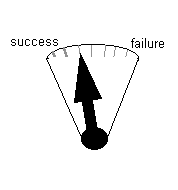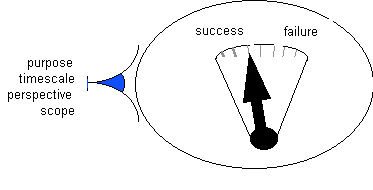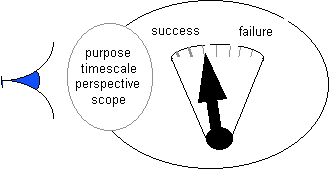
 |
Failureveryard projects > systems thinking > failure |
| we offer | understanding failure | on this page | elsewhere |
| education, training and skills
transfer
model reviews information and advice on methods and tools supporting materials - including patterns |
Identifying the causes of failure may be an essential
condition for organizational learning. Refusal to blame may lead to a refusal
to understand, or even a denial that failure has occurred / is occurring.
However, where problems are systemic or due to process design, blaming individuals obscures the problem. A blame culture also leads to an avoidance of risk. >> more
Failure and success are often thought of as alternatives, at the same logical level, but this is misleading. Compare a bridge collapsing with a bridge not collapsing.
To the extent that we may learn from failure, we are learning from a narrative in which a given engineering act is accounted a failure. We then derive generic pitfalls by generalization from supposed failures. |
What is Failure? | Crisis management |
 |
What is Failure?veryard projects > failure > what is failure |
| As a tourist attraction and landmark. | Most people have only heard of Pisa because of its famous leaning tower. |
| As an item of laboratory equipment. | Galileo is reported to have used the tower for his famous dropping-balls-off-leaning-towers experiment. |
Failure is therefore a subjective question: it depends on purpose, perspective and scope.
Scope includes timescale. You can have short-term failure and long-term success (Tower of Pisa), and you can have short-term success and long-term failure (DDT).
| Failure is an event in the ‘real’ world. Therefore beliefs and assumptions can only cause failure through affecting people’s behaviour. | |
| Failure is a (perceived) mismatch between events in the ‘real’ world and expectations in the ‘mental’ world. Cognitive errors may perhaps cause failure in two ways: either by causing ‘incorrect’ behaviour or by perverting perceptions and/or expectations. | |
| Failure is an event entirely in the ‘mental’ world (as an experience of dissatisfaction), and so may be directly caused by mental objects such as false theorems. |
These three ways of thinking about failure assume a distinction between a ‘real’ world and a ‘mental’ world, which is itself problematic.
 |
Failure and Blame (Scapegoat)veryard projects > failure > blame |
However, where problems are systemic or due to process design, blaming individuals obscures the problem. A blame culture also leads to an avoidance of risk.
‘What was most striking about these investigations, especially in the early days as the press speculated on the findings, was the tendency to focus on what, in particular, had caused the problem. It had the flavour of trying to find an appropriate scapegoat, so that certain parts of the system could be free from blame.’ [Smith & Berg, p 156]
A recent British TV programme showed a number of cases of health workers whose careers were ruined by a single error. A nurse who picked up the wrong injection after a 30 year unblemished career, and killed the patient. A pharmacist who failed to distinguish between two almost identical packs. (Obviously higher status professionals don't get scapegoated so easily.)
By blaming the individual, the system remains unaffected. Blame is therefore a mechanism for preserving the system.
With transport (e.g. rail crashes) we have two opposite tendencies. One is to automatically blame the driver or the pilot. The other is to postulate some outrageously expensive piece of technology, such as a state-of-the-art signalling and braking system, and claim that this technology would have magically eliminated all risk. The fault then lies with "The Management" for being too mean to invest in this life-saving technology.
Grief (for example the bereaved relatives) can then be converted into anger. With rail crashes, the driver's often among the dead, so it's apparently better for the relatives (and the media) to have a living target for this anger (and revenge). Another mechanism which sustains a blaming culture.
And then there's the lawyers.
| Technology and Magic
Rotten Apple Fallacy |
 |
Failure Quotesveryard projects > failure > quotes |
|
|
"A human system fails if it does not succeed in doing what it was designed to do, or if it succeeds but leaves everyone wishing it had never tried. The St Lawrence Seaway, I am told, may well exemplify the first; DDT clearly exemplifies the second." |
| "Designers focus on ... the failure of users to use the
system as the designers intended. Users, in contrast, focus on the problems
of systems that don't do what they are supposed to."
Ruth Lynne Markus, Systems in Organizations
|
|
| “Ponderous and uncertain is that relation between pressure
and resistance which constitutes the balance of power. The arch of peace
is mortised by no iron tenons: the monoliths of which it is composed are
joined by no cement. Impressive in their apparent solidity, these granite
masses lean against each other, thrust resisting hidden thrust. Yet a swarm
of summer bees upon the architrave, a runnel of April water through some
hidden crevice, will cause a millimetre of displacement, will set these
monoliths stirring against each other, unheard, unseen. One night a handful
of dust will patter from the vaulting: the bats will squeak and wheel in
sudden panic: nor can the fragile fingers of man then stay the rush and
rumble of destruction.”
Harold Nicholson, Public Faces
|
|
| “In America the rewards for worrying about others are
small indeed and the ‘do-gooders’ are an untouchable caste, contaminated
by the intangible muck of failure picked up in the dwellings of those they
have helped. For just as the shadow of an untouchable carries a contagion
that, falling upon the food of a high-caste Hindu, poisons it, so in the
West, devoting one’s life to failures contaminates one’s social personality
because somehow the odour of the disease has been communicated from the
failure to his samaritan.”
Jules Henry, Culture Against Man
|
 |
Types of Failureveryard projects > failure > types |
| We can be interested in failures of any scale, large or small. | |
| They can be failures that involve us directly, or failures that we have only witnessed indirectly. (It is usually more difficult to obtain reliable information about failures elsewhere -- people are both embarrassed and jealous about failure.) | |
| Past failures may be of more than historical interest -- they may explain the present, or may contain useful lessons for the future. Present failures may require more urgent attention. Future failures may be hypothetical or unavoidable. | |
| Failues may be acute (sudden crash) or chronic (gradual worsening). Failure can be permanent or temporary. | |
If we consider the failure of a system by comparing its performance
against a predefined standard., the system can be
|
 |
Modes of Failureveryard projects > failure > modes |
| Catastrophic
Failure |
In some situations, a gradual increase in one variable causes a gradual worsening of performance, sometimes known as "graceful degradation". In others, a gradual increase in one variable causes a sudden breakdown or "catastrophe". People usually bend under pressure, machines usually break. | |
| Complex
Failure |
Failure that is catastrophic is logically simple -- either the subsystem works or it does not. Failure that is non-catastrophic (performance degradation) cannot be combined using Boolean logic but requires more sophisticated numerical analysis. | |
| Relief
Failure |
It is proverbial that chains break at their weakest link. However, regular chains have links of approximately equal strength. When the chain breaks, each of the links may have been close to breaking point. There the failure of one link provides relief for the others. (Just mending the broken link will not provide a long-term solution -- all the links may need to be strengthened.) |
 |
Approach to Analysing Failureveryard projects > failure > analysis |
| What is the failure itself? - Event, Trend, System Performance? | |
| Is the failure acute or chronic? How urgently must the situation be repaired or remedied? | |
| Who regards this as a failure? Is there anyone (apart from competitors or rivals) who regards this as a success? | |
| Whom does the failure affect? How? | |
| Look for causes, contributing factors, effects, side effects, and other pertinent issues. Examine the failure from several viewpoints, in a systematic way. | |
| To draw useful lessons from the failure, look for the weaknesses in each subsystem. Different subsystems may be weak in different ways, susceptible to different kinds of pressure. | |
| Only given a particular kind of pressure (e.g. high throughput) does it make sense to ask which subsystem is the "weakest" link. Then you can go on to ask: how can this subsystem be strengthened against this kijnd of pressure. And once it has been strengthened, which subsystem will then be the weakest link? |
For example, what causes information system (IS) projects to fail? There
are several alternative explanations:
| The projects have obeyed the textbook approach (whatever that is), and the textbook approach has failed them | |
| The projects have disobeyed the textbook approach, and their failure can be attributed to this disobedience | |
| The projects have unsuccessfully attempted to obey the textbook approach, and their failure can be attributed to Procrustian attempts to force the project into an inappropriate mould. |
| Complexity of situation | |
| Temptation to present failure as success | |
Incorrect conclusions. Temptation to present a failed policy as an
insufficiently practised policy.
|
Level 1Treats success or failure as if they were objective characteristics of a situation, independent of the observer. |
 |
Level 2Treats success or failure as dependent on the observer.Analyses failure relative to an explicit perspective, purpose and scope. |
 |
Level 3Treats success or failure as dependent on the observation process.Analyses failure within a given discourse, in which the perspective, purpose and scope are themselves described. |
 |
 |
Book Reviewveryard projects > failure > review |
 |
| Henry Petroski, Design Paradigms: Case Histories of
Error and Judgment in Engineering
Cambridge: CUP, 1994 |
Recent failures may be difficult to analyse. ‘Even when modern case studies are available, they may provide a skewed perspective on the actual design process because of pending law suits, because of professional reputations that are at stake, or because of commitments to current theories.’ [p 10]
These difficulties can be avoided by looking at historical case studies of failure.
First generationPractical knowledge of failure modes Cautious innovation |
Second generationTheoretical/no knowledge of failure modes Reckless innovation |
This happened with Gothic cathedrals in the late Middle Ages, and it happened with iron bridges in the nineteenth century. Most of the first generation constructions are still standing; many of the second generation constructions were over-ambitious and fell down.
In support of this, Petroski cites Alexander [1964, p 53]: "Although only a few men have sufficient integrative ability to invent form of any clarity, we are all able to criticize existing forms."
Alexander’s footnote quotes Pericles [Thucydides, ii, 41]: "Although only a few may originate a policy, we are all able to judge it."
But contrast this with "Giambattista Vico’s aphorism that one truly understands only what one can create" [Mumford, pp 66-7]
But surely Petroski isn’t equating failure with criticizability. Yes, even Prince Charles can criticize the National Theatre building, but in what sense does that make it a failure? (Unless we regard Prince Charles as the representative of the zeitgeist.)
 |
Referencesveryard projects > failure > references |
 |

|
Henry Petroski, Design Paradigms: Case Histories of Error and Judgment in Engineering. Cambridge: CUP, 1994 |

|
|
Other References |
Christopher Alexander, Notes on the Synthesis of Form (Harvard University Press, 1964) |
|
|
| Yehezkel Dror, in Tomlinson & Kiss (eds), Rethinking the Process of Operational Research and Systems Analysis (Oxford: Pergamon Press, 1984) p 106 |
|
|
|
| Lewis Mumford, Myth of the Machine (Secker & Warburg, 1967) |
|
|
|
| H.S. Schwartz, Narcissistic Process and Corporate Decay: The Theory of the Organizational Ideal (New York: New York University Press, 1990) |
|
|
|
| K.K. Smith & D. N. Berg, Paradoxes of Group Life (San Francisco: Jossey Bass, 1987) |
|
|
|
| Vitruvius, The Ten Books on Architecture. Translated by Morris Hicky Morgan. (Harvard University Press, 1914) (reprinted by Dover Publications, New York) |
|
|
| top |  |
|
Copyright © 1994-2004 Veryard Projects Ltd http://www.veryard.com/tcm/failure.htm |